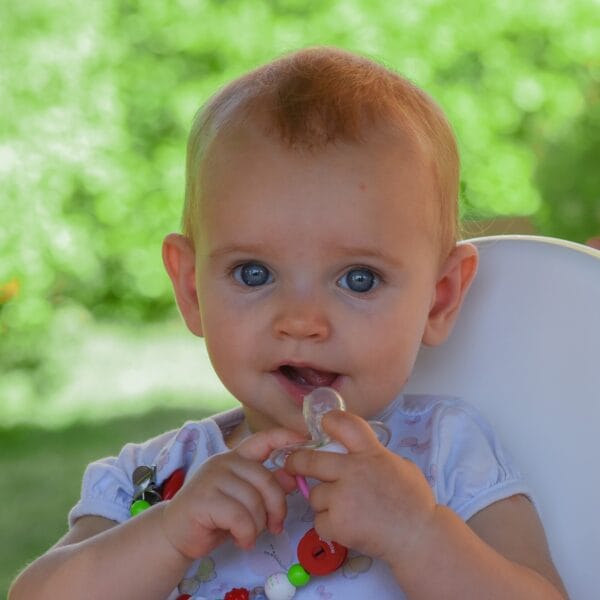Sleep Training with a Pacifier: A Gentle Approach to Better Nights
When it comes to getting a baby to sleep through the night, many parents are willing to try just about anything. Sleep training is a common approach to help babies learn to fall asleep on their own, but it can often be a challenging process. One tool that parents sometimes use to ease this transition is a pacifier. But is sleep training with a pacifier effective? And how do you navigate the potential pitfalls?
This article will explore the ins and outs of sleep training baby with a pacifier, providing a comprehensive guide for weary parents seeking restful nights.

Understanding the Role of Pacifiers in Sleep
![]()
Before diving into sleep training with a pacifier, it’s essential to understand why pacifiers can be so effective. A baby sleeping with a pacifier often experiences a soothing effect, as sucking is a natural reflex that can calm and settle a child. Here’s why many parents consider using a pacifier as part of their sleep training strategy:
- Comfort: Pacifiers can provide a source of comfort to babies, which can help them self-soothe and fall asleep more easily.
- Distraction: In some cases, a pacifier can distract a baby from the act of falling asleep, which can sometimes be stressful for little ones.
- Reduced risk of SIDS: Several studies have suggested that pacifiers may decrease the risk of sudden infant death syndrome (SIDS), providing an added incentive for their use at bedtime.
However, it’s worth noting that pacifiers are not without their downsides. Some babies can become dependent on them, leading to disrupted sleep if the pacifier falls out during the night. Additionally, long-term pacifier use can potentially lead to dental issues, although this is more of a concern as the child gets older.
When to Introduce a Pacifier for Sleep Training
![]()
Deciding when to introduce a pacifier is a personal choice, but there are a few factors to consider:
- Establishing breastfeeding: If you’re breastfeeding, it’s generally recommended to wait until nursing is well-established before offering a pacifier. This typically takes about 3-4 weeks.
- Early sleep cues: Introducing a pacifier once you’ve begun to notice your baby’s sleep cues can help associate the pacifier with bedtime and sleep.
- Baby’s preference: Some babies take to pacifiers readily, while others show little interest. Observing your baby’s preference can guide your decision.
Methods of Sleep Training with Pacifier
![]()
There are various sleep training methods, and many can be adapted to include a pacifier. Here are a few popular techniques:
- Gradual retreat: Also known as the ‘chair method,’ this involves sitting near your baby as they fall asleep and gradually moving further away over time. A pacifier can be used to help soothe the baby as they adjust to falling asleep without your presence.
- Check-and-console: This method involves putting your baby to bed with a pacifier and then leaving the room. If they cry, you check on them at increasing intervals, offering comfort but not picking them up. The pacifier provides an additional source of comfort.
- Pick up/put down: With this approach, you would give your baby a pacifier and then pick them up to soothe them when they cry, but put them down again as soon as they’re calm.
Regardless of the method you choose, consistency is key. Establishing a routine and sticking to it will help your baby learn what to expect at bedtime.
Can Baby Sleep with Pacifier All Night?
![]()
One of the biggest questions parents have is whether it’s safe and practical for their baby to sleep with a pacifier all night. The short answer is yes, it can be safe, but there are a few considerations to keep in mind:
- Safety: Ensure the pacifier is of a safe design, with a shield that’s larger than the baby’s mouth to prevent choking, and inspect it regularly for wear and tear.
- Reinsertion: If your baby relies on the pacifier to sleep, you may need to reinsert it several times throughout the night if it falls out.
- Independence: Teaching your baby to put the pacifier back in themselves can be a game-changer. This usually becomes possible when they’re a little older, around 6-7 months.
Dealing with Pacifier Dependence
![]()
While pacifiers can be a valuable tool for sleep training, dependence on them can become an issue. Here’s how to manage it:
- Weaning off: Gradually reducing the use of the pacifier can help your child learn to fall asleep without it. Start by limiting pacifier use to naps and bedtime, then to bedtime only, and finally removing it altogether.
- Replacement comfort: Introduce a comfort object like a small blanket or stuffed animal to take the place of the pacifier once your baby is old enough to safely have such items in the crib.
Remember that every baby is different, and what works for one may not work for another. It’s important to be flexible and patient as you navigate sleep training with a pacifier.
Troubleshooting Common Challenges
![]()
Here are some solutions to common problems parents face when sleep training baby with pacifier:
- Pacifier falls out: Once your baby has the motor skills, teach them to put the pacifier back in themselves. Until then, consider using a pacifier that’s easier to grasp or has a stuffed animal attached to make it more accessible.
- Baby rejects the pacifier: Not all babies will take a pacifier. If yours doesn’t, focus on other soothing techniques like swaddling, white noise, or gentle rocking.
- Night wakings: If your baby wakes up because the pacifier has fallen out, give them a few minutes to see if they’ll settle back to sleep on their own before intervening.
It’s also worth noting that while pacifiers can be a helpful tool, they’re not a guarantee for better sleep. Sleep training is often a process of trial and error, and it’s important to stay adaptable.
Frequently Asked Questions
![]()
What is sleep training with a pacifier?
Sleep training with a pacifier involves using a pacifier to help soothe and settle your baby to sleep. The idea is to give your baby the comfort they need to fall asleep on their own without being held or rocked.
At what age can I start sleep training my baby with a pacifier?
You can introduce a pacifier as early as you like, but sleep training is usually recommended for babies around 4 to 6 months old. This is when they naturally start to develop the ability to self-soothe.
How do I introduce the pacifier to my baby for sleep training?
Start by offering the pacifier to your baby when they are calm but drowsy. Hold the pacifier in place gently and encourage your baby to take it. If they seem interested, they may start to suck on it and settle down to sleep.
Can a pacifier help my baby sleep through the night?
A pacifier can provide comfort and help your baby self-soothe, which might help them sleep longer stretches. However, it’s not a guarantee for sleeping through the night as each baby’s sleep patterns are different.
What if my baby keeps spitting out the pacifier?
Some babies take time to get used to a pacifier. If your baby spits it out, you can try placing it back in a few times. If they consistently refuse it, they might not be ready for a pacifier or simply don’t prefer it.
Will using a pacifier create a bad habit or dependency?
Many babies use a pacifier without developing a long-term dependency. However, it is possible for a child to become dependent on it for sleep. To prevent this, consider weaning your child off the pacifier gradually, usually around their first year.
How should I respond if the pacifier falls out during the night?
If the pacifier falls out and your baby is still asleep, there’s no need to put it back in. If they wake up and seem upset, you can replace the pacifier to help them settle back to sleep.
What are the best practices for keeping the pacifier clean?
Always sterilize a new pacifier before the first use and regularly clean it with hot, soapy water. Check the pacifier for damage regularly and replace it every few months or sooner if it shows signs of wear.
Can using a pacifier cause dental problems?
Using a pacifier during the early months typically doesn’t cause dental problems. However, prolonged use, especially past the age of two, can lead to dental misalignment or bite problems.
How do I wean my baby off of the pacifier?
Begin by limiting pacifier use to naptime and bedtime. Then, gradually decrease use during these times as well. Offer other forms of comfort, like a stuffed animal or blanket. Be consistent and patient as your baby adjusts to sleeping without the pacifier.
Conclusion: Bringing Peace to Bedtime
![]()
Sleep training with a pacifier can be a gentle way to ease your baby into sleeping through the night. By providing comfort and a sense of security, pacifiers can help create a positive sleep association and make the process smoother for both baby and parents. However, it’s important to be aware of the potential for dependency and have a plan for weaning off the pacifier when the time is right. Remember that every child is unique, and what works for one may not work for another. Patience, consistency, and a willingness to adapt your approach will ultimately help you find the best sleep solution for your little one.
As with any aspect of parenting, there’s no one-size-fits-all answer to sleep training. But with the right information and a bit of perseverance, you can find a sleep training method that works for your family and enjoy the benefits of a good night’s sleep for everyone involved.





